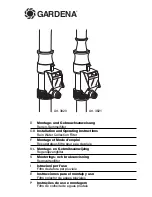
19
6. Place the injection tube avoiding as much as possible the curves and ensuring that the pulses do not make the tube rub
against rigid bodies.
7. Perform electrical connections (see related section in the manual) and power the pump.
8. At the injection point on the pipeline, mount a ½” GAS connection, internally threaded (not supplied).
9. Wrap PTFE tape to the thread and tighten the injection valve to the fitting.
10. Unscrew the pipe-wrench nut of the injection valve fitting.
11. Cut the white, semi-rigid, PE tube.
12. Insert the pipe-wrench on the PE tube.
13. Mount the tube on the conic hose of the injection valve, pushing it until it reaches the stop collar.
14. Screw the pipe-wrench nut on to the valve fitting.
Note:
The injection valve also works as non-return valve: do not disassemble it internally.
ELECTRICAL CONNECTIONS
The EFka270 unit is supplied already wired internally and complete with power cable (with plug upon request).
This is the only electrical connection to be performed by the customer.
Standard power supply: 230 V
∼
, 50 Hz, monophasic.
Carefully follow all the rules of electrical safety.
Before starting the unit, check that all electrical and plumbing connections have been properly executed.
The measure inputs from pH and redox electrodes are available on BNC connectors, while inputs for level sensors
(one for each pump) and flow sensor are available on special connectors that allow an extremely fast and easy connection
even for unskilled personnel.
Note:
the pH and redox inputs should never be left open; if an input is not used, you need to short-circuit it.
Level Control
The system is supplied already configured for disabling the dosage in case of low level in the tank. The
level control is made through a specific float sensor (optional, see “Accessories and spare parts”), to be
connected to pins 3 and 4 of the LEV connector (see Figure)
When the product level in the tank falls below the level sensor, the unit stops dosing and the fault is
shown on the display.
The alarm condition is generated with a delay of a few seconds compared to the detection of low level, to
avoid errors due to extreme situation (such as water surface).
Two inputs for level sensor are available, one for each pump / tank.
Flow Control
The system is supplied already configured for disabling the dosage in case of lack of water flow.
The control is made through a SPDT contact to be connected to pins 3 and
of the FLOW connector
(see Figure). A specific flow sensor is also available (optional, see “Accessories and spare parts”).








































